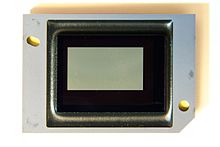Digital micromirror device
This article has multiple issues. Please help improve it or discuss these issues on the talk page. (Learn how and when to remove these template messages)
|

The digital micromirror device, or DMD, is the microoptoelectromechanical system (MOEMS) that is the core of the trademarked Digital Light Processing (DLP) projection technology from Texas Instruments (TI). Texas Instrument's DMD was created by solid-state physicist and TI Fellow Emeritus Dr. Larry Hornbeck in 1987.[1] However, the technology goes back to 1973 with Harvey C. Nathanson's (inventor of MEMS c. 1965) use of millions of microscopically small moving mirrors to create a video display of the type now found in digital projectors.[2]
History
The DMD project began as the deformable mirror device in 1977 using micromechanical analog light modulators. The first analog DMD product was the TI DMD2000 airline ticket printer that used a DMD instead of a laser scanner.[3]
Construction and use
A DMD chip has on its surface several hundred thousand microscopic mirrors arranged in a rectangular

The mirrors themselves are made of aluminum and are around 16 micrometers across. Each mirror is mounted on a yoke which in turn is connected to two support posts by compliant
Two pairs of electrodes control the position of the mirror by electrostatic attraction. Each pair has one electrode on each side of the hinge, with one of the pairs positioned to act on the yoke and the other acting directly on the mirror. The majority of the time, equal bias charges are applied to both sides simultaneously. Instead of flipping to a central position as one might expect, this actually holds the mirror in its current position. This is because the attraction force on the side the mirror that is already tilted towards is greater since that side is closer to the electrodes.[8]
To move the mirrors, the required state is first loaded into an
The bias system is used because it reduces the voltage levels required to address the pixels such that they can be driven directly from the SRAM cell, and also because the bias voltage can be removed at the same time for the whole chip, so every mirror moves at the same instant. The advantages of the latter are more accurate timing and a more cinematic moving image.

The described failure mode on these is caused by internal contamination usually due to seal failure corroding the mirror supports. A related failure was the glue used between 2007 and 2013, under which heat and light degrades and outgasses: this normally causes fogging inside the glass and eventually white/black pixels. This cannot usually be repaired, but defective DMD chips can sometimes be used for less critical projects not needing rapidly changing patterns if the existing bad pixels can be made part of the projected image or otherwise mapped out, including 3D scanning. [9]
Applications
- Televisions and HDTVs
- Holographic Versatile Discs
- Head-mounted displays
- Digital cinema[10]
- DLP projectors
- Optical Metrology[11]
- Laser Beam Machining[12]
- Phase space measurement with forward modeling[13]
- Spatial Light Modulation[14]
- Multivariate optical computing
- Digital Holographic Tomography[15]
- Optogenetics[16]
- Flip-disc display
References
- ^ "Larry Hornbeck, Digital Micromirror Device, US Patent No. 5,061,049, Inducted in 2009" Archived 2016-03-03 at the Wayback Machine, "National Inventors Hall of Fame"
- ^ US patent 3746911, Nathanson et al, "Electrostatically deflectable light valves for projection displays", issued 1973-7-17
- ^ Johnson, R. Colin (2007-01-29). "TI fellow on DLP: We did it with mirrors". EE Times. Retrieved 2021-05-29.
- ^ Sasaki, M. (2021). Metal Surface Micromachining. In 3D and Circuit Integration of MEMS, M. Esashi (Ed.). https://doi.org/10.1002/9783527823239.ch6
- ISBN 978-0-470-77091-7.
- ^ Akride, Mike; Butler, Tim J.; Moss, Graham H. (August 1, 1999). "Digital micromirror yields bright array of colors". Laser Focus World. Retrieved 2021-06-07.
- S2CID 33779816.
- doi:10.1016/S0304-3886(01)00159-0. Archived from the original(PDF) on 2021-09-23. Retrieved 2021-05-29.
- ^ Schirmer, Eric. "Explanation of DLP chip failure: white dots and white haze?". DLP® products - DLP products forum. Texas Instruments Inc. Retrieved 2019-12-19.
- ^ "Plano Cinema Firm To Open Theater With Digital Projection, Self-Serve Snacks". Texas Business. Old Mesquite LLC. 2010-10-25. Archived from the original on 2012-01-26. Retrieved 2011-10-24.
- ^ Barreto, Raul (2011-05-13). "Using DLP® Development Kits for 3D Optical Metrology Systems" (PDF) (Application Report). DLPA026. Texas Instruments. Retrieved 2021-05-29.
- ISSN 2159-3930.
- ^ Liu et al., 2015 "3D imaging in volumetric scattering media using phase-space measurements"
- PMID 35546600.
- S2CID 46878533.
- ^ "State-of-the-Art Illumination Technology". Polygon Cellular-Resolution Optogenetics & Photostimulation. Mightex Systems. Retrieved 2021-05-28.
